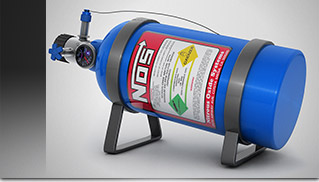 When it comes to increasing engine performance, there are a wide variety of performance parts on the market, and most are designed to do one thing: increase the amount of air and fuel the engine can pull into the cylinder on the intake stroke. The more air and fuel the engine can pack into the cylinders on the intake stroke, the greater the peak horsepower of the engine.
When it comes to increasing engine performance, there are a wide variety of performance parts on the market, and most are designed to do one thing: increase the amount of air and fuel the engine can pull into the cylinder on the intake stroke. The more air and fuel the engine can pack into the cylinders on the intake stroke, the greater the peak horsepower of the engine.
There is another method, though, that doesn’t require standard hot rodding tricks like changing blocks, pistons, camshafts and such engine hardware. It simply introduces a gas called nitrous oxide into the engine and this can create an astonishing amount of additional power.
To understand how nitrous oxide works, let’s quickly review how an engine operates. A gasoline engine’s operation depends on three factors: fuel, air and spark. The engine takes in air and fuel and ignites it with the spark. The ignited mixture results in hot, exploding gases that push pistons down their cylinders, turning the crankshaft rapidly and transferring power downstream to the wheels.
Nitrous oxide is a gas composed of two nitrogen molecules bonded to one oxygen molecule, hence, the chemical name of N2O. It stays in liquid form under pressure and converts to a gaseous state when released into the atmosphere. Nitrous oxide is an oxidizer. An oxidizer enhances combustion by supplying additional oxygen to the burning process. Initially, the nitrous doesn’t help the process. Only after nitrous has been exposed to the heat of the combustion process will the chemical bond between the three atoms be broken allowing the free oxygen molecule to contribute to the combustion process. The end result is more horsepower being created pretty much the same way a blower or turbocharger does.
There are two main types of nitrous systems for automotive performance use – wet and dry systems. Wet nitrous systems come with their own fuel hardware which allow you to introduce more fuel to your intake charge and increase horsepower. Dry nitrous systems, on the other hand, don’t come with hardware and use your existing fuel system components. Dry nitrous systems are generally easier to set up between the two simply because you don’t have the added fuel components to install. Most do-it-yourselfers prefer dry systems
Cost? You can purchase a nitrous kit, brand new for around $500 with everything you really need to start using it, maybe as much as $700 if you get all the bells and whistles. With kits in this price range you can instantly add some 15, 35, 55, 65, 75, 125 or even 150 horsepower to your car. The nitrous refills are about $40-50 or so at the time of this writing.
Safety and legality is one concern that should be addressed. Nitrous is not without risk. Compressed gas has to be treated with respect. A punctured compressed gas container can become a rocket, and excessive heat can cause a compressed gas container to explode. Check your local laws because in some states it is illegal to have nitrous in the vehicle, in others it’s legal with certain rules (can’t be open/hooked up), and in others there are no regulations on the books at all.
If you are considering a nitrous system for your car you will find a huge amount of information on the web. There are many reputable nitrous system dealers in addition that can provide you with invaluable support if you decide to “add the juice”.
Courtesy of: Hoover the Mover